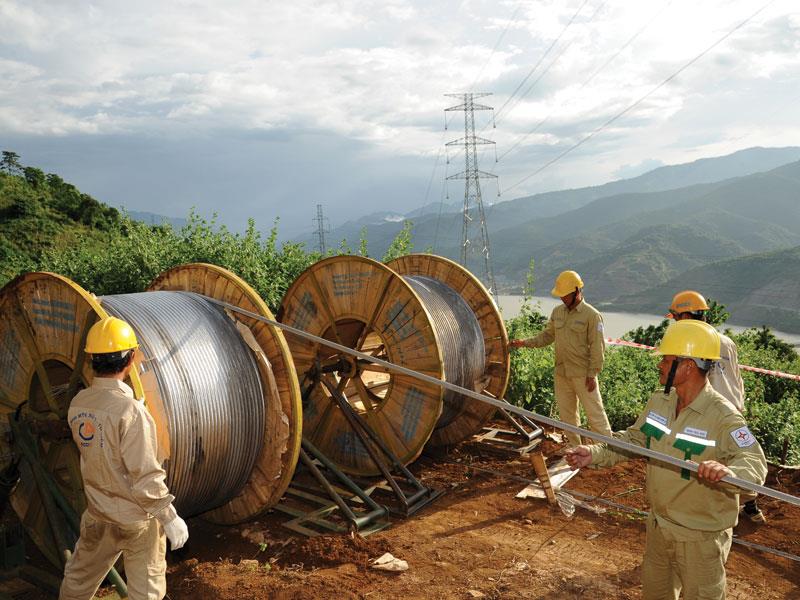To prepare diesel generators now in January 2016, to take the advantage of the weather, and to save water discharge for agriculture are under control, conducted by the power industry, with general goal to save water for power generation.
Saving 2 billion cubic meters
Thanks to favorable weather and strict monitoring process of the irrigation sector and the electricity sector, though interrupted by Lunar New Year Festival 2016, the plan for water discharge of the hydro-power reservoirs serving the agricultural production in the Winter-Spring Crop 2016 in 12 provinces and cities of the Northern midland and delta has been significantly changed.
Earlier, under the agreement of the General of Water Resources and Electricity of Vietnam (EVN), it is to ensure sufficient water, the hydro-power reservoirs will have 3 rounds of discharge for 21 days with 5.16 billion m3. Specifically, Thac Ba reservoir discharges 0.829 billion m3; Tuyen Quang Lake discharges 1,108 billion m3 and Hoa Binh reservoir discharges 3.221 billion m3.

351 additional electricity works to be completed in 2016 to ensure stable power supply
Mr. Nguyen Van Tinh, Deputy General Director of General Department of Irrigation states that, during the past 10 years, thanks to the large reservoirs such as Thac Ba and Tuyen Quang, and Hoa Binh, the 12 provinces in the northern delta and midland have been guaranteed with reliable irrigation for agricultural production in Winter-Spring season crops with a total area of 630,000 hectares to be well irrigated. Recognizing the actual discharged amount of water from the hydro reservoirs for production in the northern winter-spring crop tends to increase during the past few years, Mr. Tinh attributes it to the impact of the El Nino phenomenon, causing lower precipitation.
Before Phase 1 discharge, the irrigation sector is very much concerned about the water level in the rivers which is very low, at many places it is only from 0.2-0.4 m in depth, so the amount of water needed to raise the water level buffer on the river up to 2.2 m at the Hanoi passage on the Red River, sufficient for pump operation will need more volume. Besides, the Red River bottom in the past few years has been lowered by 20%, the Duong river bottom is lowered by 40%, requiring more volume for compensation of level.
However, as reflected by the General Department of Irrigation, due to the good combination of directives and governance, and local management, and especially favorable rainfall, so the water discharge duration in Phase 1 has been shortened by 1.5 days, with no need for Phase 2 discharge and 2 days shortened for Phase 3 discharge. This reality helps the hydro power reservoirs save about 2 billion m3 of discharged water.
Full Concern of Hydro Power in Dry season
In planning for electricity supply in 2016, the volume of water in hydropower reservoirs remain a shortage, equivalent to a power output of 2.5 billion kWh. Meanwhile, the forecast is favorable for hydrology, with possibility of widespread drought in the first half of 2016 and even a longer duration, due to El Nino, so the operation of hydropower reservoirs to produce electricity and to irrigate the agricultural production, to feed water for livelihood downstream would be very tough.
Mr. Ngo Son Hai, the Deputy General Director of EVN said, although EVN has actively accumulated water in lakes during the flooding season in 2015 but no flood came in the rivers, thus by December 31, 2015, the water level in large hydropower reservoirs is still lower than normal designated level, especially in the central region and the Central Highlands.
According to the National Load Dispatch Center (A0), the total volume of water in hydropower reservoirs when compared to normal water level on 31st Dec 2015 represents a shortfall of approximately 6.5 billion m3; in which the North deficiency is nearly 2.3 billion m3, Central deficiency is over 2 billion m3 and South deficiency is 2.1 billion m3.
Thus the savings of 2 billion m3 of water, retained from discharge within the first months of the dry season in 2016 is significant to assist the power sector with more reserved capacity.
"In November 2015, EVN submitted four power supply plans for 2016, then the Ministry of Industry and Trade has selected and approved a formal plan. However, the actual demand for electricity during the first months of 2016 is higher than the approved plan. So, immediately starting January 2016, EVN had to mobilize some diesel resources in the southern establishment to keep the water in the hydro power reservoirs, and many hydro-power plants are generating power on the demand for irrigation in the downstream areas” said Mr. Son Hai.
Currently, there are 81 hydropower plants (over 30 MW in size) in operation with a total capacity of 15,570 MW, representing 40.4% of the total installed capacity of the system. Among these, there are 26 hydro reservoirs regularly operating under local requirements to meet for downstream irrigation.
As reported by EVN, in 2016, the total capacity of the national power is 38,800 MW, the total capacity of the power supply is expected to operate in 2016 is 3,500 MW. Of this, EVN will put into operation 9 generating units with total capacity of 2,534 MW, consisting of Unit No. 2 and No. 3 of Lai Chau Hydropower Plant, Unit 2 Huoi Quang Hydropower Plant; Units 1 and 2 of Trung Son hydropower plant, and the Song Bung 2 hydropower plant, and the Duyen Hai 3 Thermal Power Plant.
There are also 351 grid extension works from the 110 kV to 500 kV with a total length of 4,800 km, the total capacity of 21,890 MVA substation, planned for completion by units of EVN in 2016 to ensure its stable power supply.
Trong Tan
